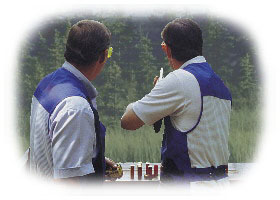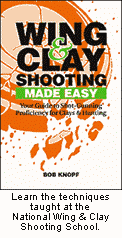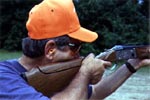|
|
 |
 |
Ten Tips To Better Wing & Clay Shooting by Bob Knopf
Consider these 10 shooting tips to develop your maximum shotgun shooting potential.
Tip #1 - In all shooting, practice safety first. Always wear hearing and eye protection. Keep your gun unloaded and the action visibly open until you're ready to shoot. Once you are finished shooting, make sure the gun is once again empty and the action is open. Always keep the gun's muzzle pointed down range. Never point a gun muzzle backward over your shoulder. Tip #3 - When shooting (or practicing your swing/mounts), position your feet so that a line extending from your rear heel to your leading foot points to where you will break the target. Keep your stance relatively narrow. This position encourages a smooth swing and a good follow through. Tip #4 - Learn to first swing the gun and then mount it. If we mount the gun as we swing to the target, the mount takes no time. Allow your pointing instincts to take over your swing. As your eyes become sharply focused on the target, finish the gun mount and shoot the instant the target is in sharp focus. Tip #5 - When pointing your gun, focus on the target and not the gun barrel or bead. Point, don't aim. Aiming slows your swing and causes you to shoot behind. Since a shot string is 10-14' long, use it to your advantage by pointing slightly more in front of a target. If you miss crossing targets, you are probably shooting behind. Try to "miss" in front by doubling your lead, and if still missing, try doubling the lead again. Tip #6 - Gun fit is important. Have your gun fitted so it shoots where you look. This test requires that you first have a consistent, well practiced gun mount. To test for gun fit, set up a pattern board at 16 yards. Fire several consecutive shots by mounting and shooting at a center dot without aiming, but by merely pointing at the target. If the highest pattern density is off center, take the target and your gun to a competent gun fitter for adjustment. Tip #7 - When shooting simultaneous (true) pairs, decide ahead of time which target you will break. Generally, shoot the behind or lower target first, unless one target is quick to disappear behind cover or is decidedly more difficult. Shooting the lower target first allows gun recoil to bring you automatically to the upper target. Shooting the back target first allows your swing to continue smoothly to the front target.
Tip #9 - Use low recoil target loads for practice. Shotshells containing 7/8-1 oz shot are adequate for practice. The lessened amount of shot with more powder gives these shells high velocity, low recoil, and excellent pattern integrity. Many tournament shooters prefer these light loads even under tough tournament shooting conditions. Tip #10 - Regular practice improves scores. However, when practice no longer improves your hitting ability, take a lesson from a certified NSCA instructor. A competent instructor can diagnose specific shooting problems and improve your proficiency. The dollars paid to a competent instructor are quickly returned in better scores and saved ammunition.
The National Wing & Clay Shooting School Increases Shooting Skills If you want to improve your skills on the upland bird fields, at your favorite waterfowl marsh, or at the skeet, trap or sporting clays range, the National Wing & Clay Shooting School travels nationwide to clubs and corporate events. Instruction is by top level NSCA instructors who teach all wing shooting methods. You'll learn the shooting methods that fit your shooting style, custom tailored to your specific needs. Instruction is individual, and all skill levels are taught. Also, learn the techniques taught at the National Wing & Clay Shooting School in a new book, Wing & Clay Shooting Made Easy. |
 |
|
|
Site design by Copyright © 1996-2007 Outdoor Management Network Inc. America Outdoors® is a registered trademark of Outdoor Management Network Inc. |
 All shotgun shooters want to shoot better. But for many
shooters, a handful of shooting mistakes create frustration in
the field or on the range. Instructors at the National Wing & Clay Shooting School help
shooters at all skill levels gain proficiency by eliminating
mistakes and by helping each shooter trust their instincts.
All shotgun shooters want to shoot better. But for many
shooters, a handful of shooting mistakes create frustration in
the field or on the range. Instructors at the National Wing & Clay Shooting School help
shooters at all skill levels gain proficiency by eliminating
mistakes and by helping each shooter trust their instincts.
 Tip #8 - When you're experiencing a missing streak, change
something. Change one of your postures. Double your lead. Or,
give yourself less think time by moving your gun hold point and
target view point closer to the break point. Pull the trigger
the instant the gun is mounted to your face and the target is
in focus.
Tip #8 - When you're experiencing a missing streak, change
something. Change one of your postures. Double your lead. Or,
give yourself less think time by moving your gun hold point and
target view point closer to the break point. Pull the trigger
the instant the gun is mounted to your face and the target is
in focus.